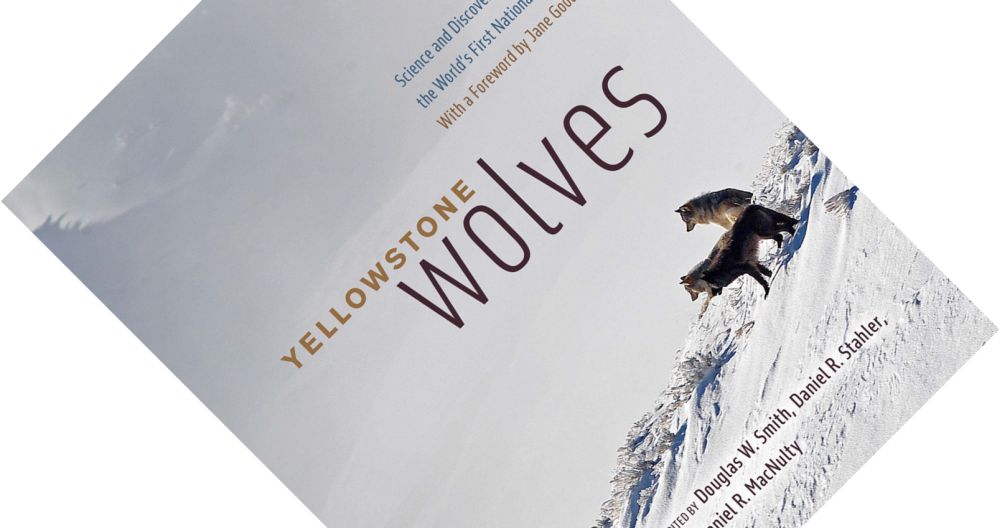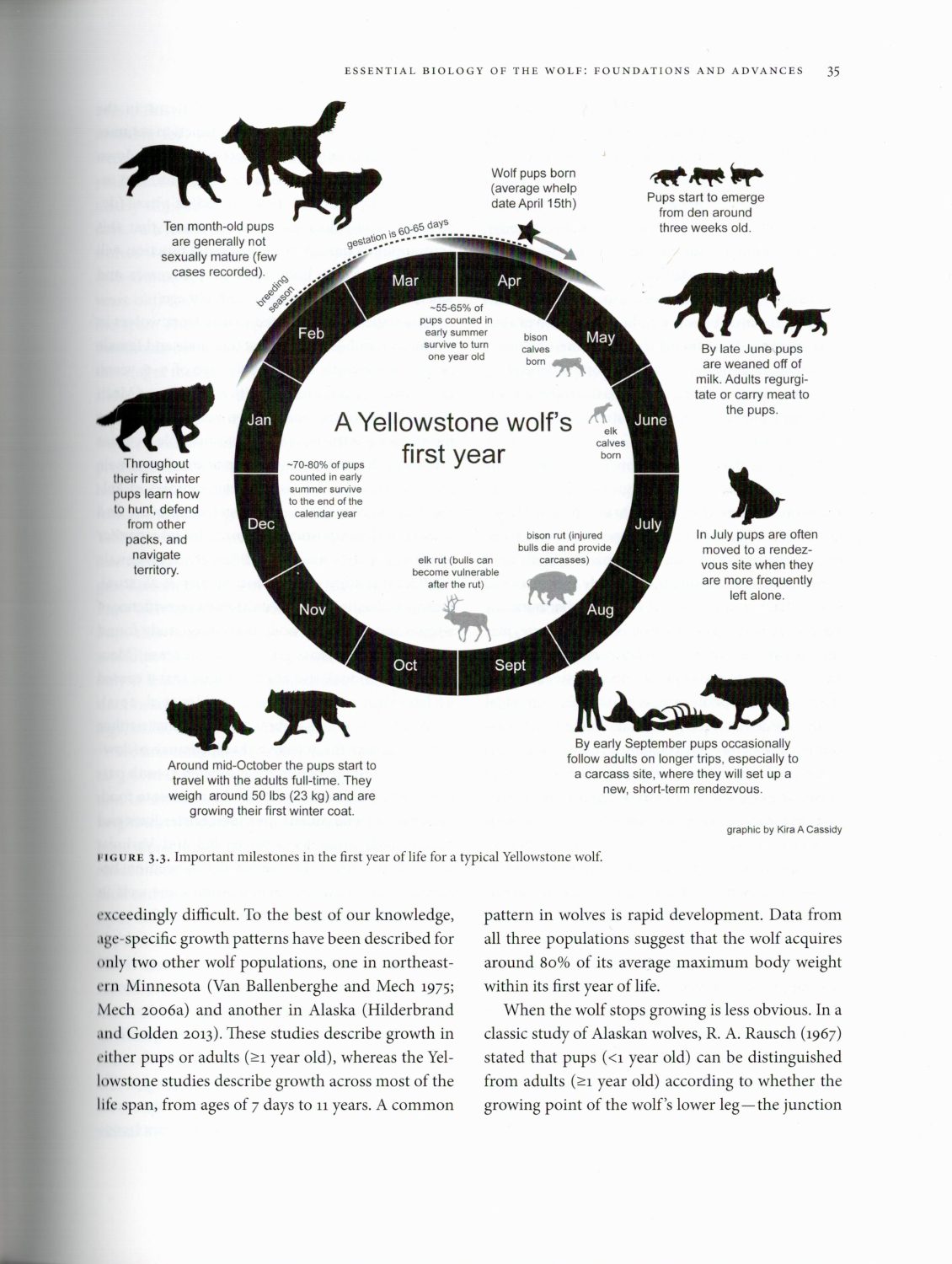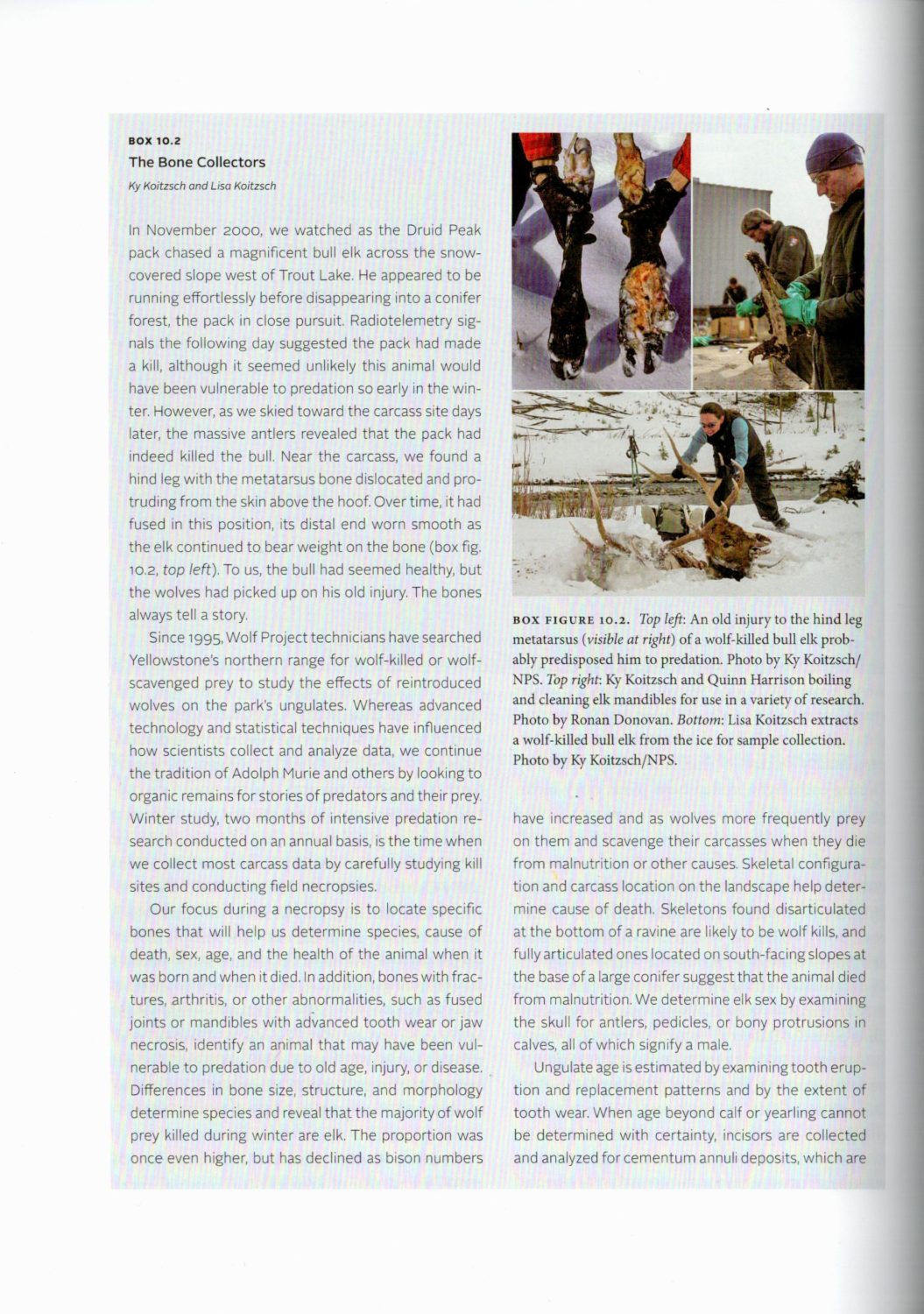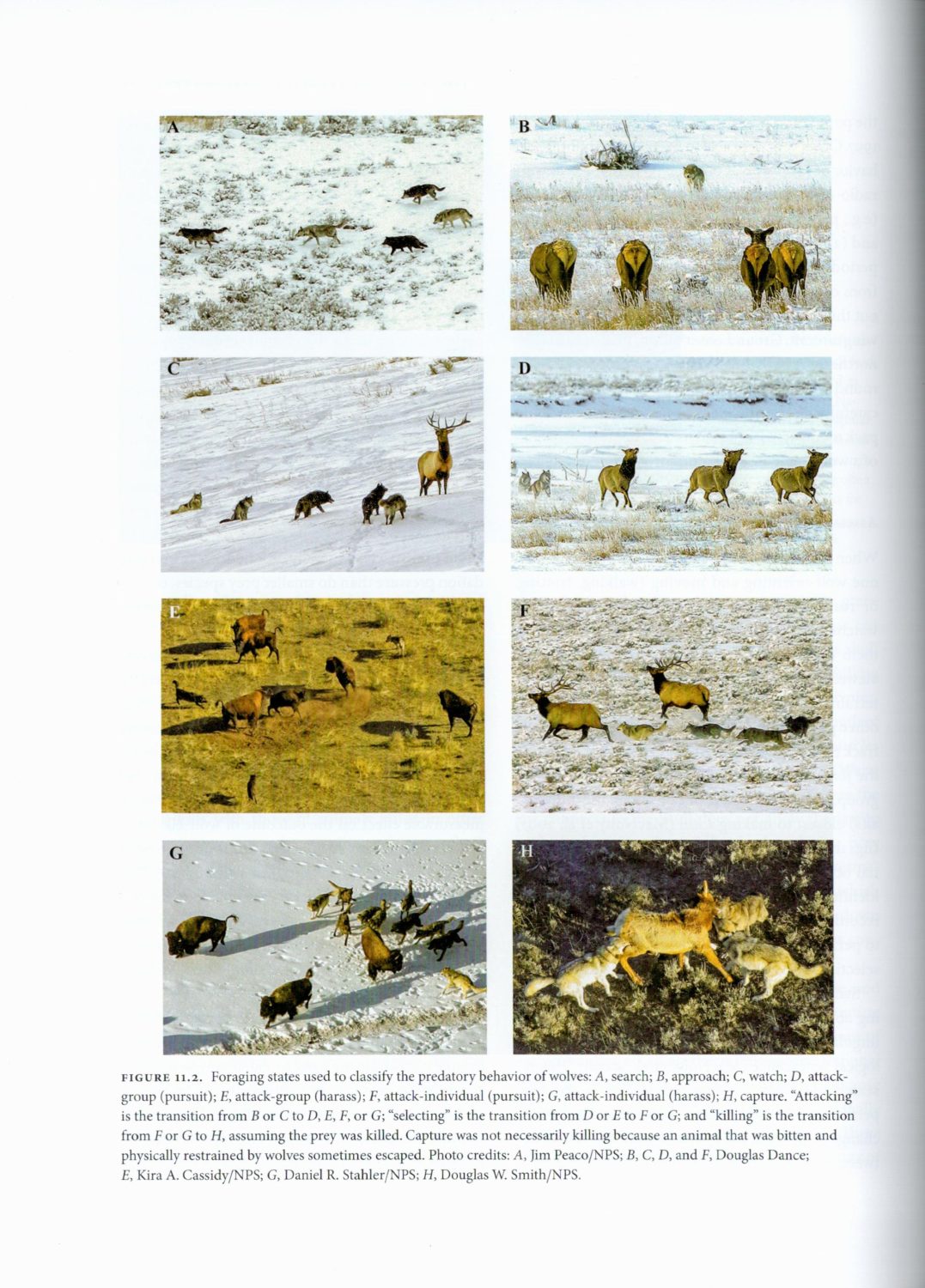7-minute read
The reintroduction of wolves to Yellowstone National Park is one of the best-known examples of wildlife conservation. To celebrate its 25th anniversary and summarise the many lessons learned, Yellowstone Wolf Project leaders Douglas W. Smith and Daniel R. Stahler, together with wildlife ecologist Daniel R. MacNulty, bring together research from over 70 colleagues in this large, edited collection. The combination of academic content, excellent photography, guest essays, and an online bonus documentary with interviews make this the go-to reference work for anyone wanting to go beyond the headlines on this reintroduction project.

Yellowstone Wolves: Science and Discovery in the World’s First National Park, edited by Douglas W. Smith, Daniel R. Stahler, and Daniel R. MacNulty, published by the University of Chicago Press in December 2020 (hardback, 339 pages)
The first thing that struck me about Yellowstone Wolves is how well-organised the book is. Six parts contain nineteen chapters, none going beyond twenty pages, and most include a clearly signposted conclusion. To give equal airtime to so many different studies and opinions is remarkable—the six years the editors spent on this book have borne fruit. The second thing is how readable the book is. To do justice to the subtleties and complexities of real-world ecosystems means digging into scientific research. Thus, it discusses methodologies and research results and provides graphs galore,  but without bogging the reader down with excessive jargon or complex statistics. Only occasionally, when the discussion turned to species interactions or ecosystem ecology, did I feel that I was reading an academic paper.
but without bogging the reader down with excessive jargon or complex statistics. Only occasionally, when the discussion turned to species interactions or ecosystem ecology, did I feel that I was reading an academic paper.
So, what have we learned from 25 years of having wolves back in Yellowstone? This book covers a wide range of topics, more than I can hope to discuss here. Sensibly, it opens with a short history of the park, wolf extermination, and the reintroduction—a dramatic story complete with last-minute lawsuits that almost scuppered the whole operation.
“The first thing that struck me about Yellowstone Wolves is how well-organised the book is. […] To give equal airtime to so many different studies and opinions is remarkable”
After some basic wolf biology, the bulk of the book discusses long-term research. This covers pathogens and parasites, the genetic studies that inform wolf pedigrees and explain why you see both black and grey wolves in the park, and, notably, the different aspects of wolf packs. How they form, how long they last, how they defend territories and compete with one another, and how they change over time. This introduces some of the legendary wolves from Rick McIntyre‘s Alpha Wolves of Yellowstone series, or the very popular female O-Six, but also reveals the value of older wolves to their pack, or the surprisingly high mortality due to intraspecific (i.e. wolf-wolf) conflict when wolves are not constantly hunted by humans.
 My impression, however, is that the seven chapters across parts 4 and 5 will be the most relevant to many readers. Why? First, because the chapters on community ecology (particularly wolf-prey interactions) touch both on the concerns of the hunters and ranchers who opposed wolf reintroduction, and on the challenges faced by generations of park managers. Second, because the topic of ecosystem ecology (the effects of wolves on ecosystems) catapulted the park to internet fame.
My impression, however, is that the seven chapters across parts 4 and 5 will be the most relevant to many readers. Why? First, because the chapters on community ecology (particularly wolf-prey interactions) touch both on the concerns of the hunters and ranchers who opposed wolf reintroduction, and on the challenges faced by generations of park managers. Second, because the topic of ecosystem ecology (the effects of wolves on ecosystems) catapulted the park to internet fame.
We are going to need some history here.
Woven throughout this book is the story of how predator removal at the beginning of the 20th century saw elk populations boom, leading to concerns of too many elk overgrazing and trampling the park and surrounding farmland. From 1920 to 1968 park management and hunters culled and relocated tens of thousands of elk, leading to concerns of too few elk and, from 1969 onwards, new policies that let nature take its course. Predictably, without predators, there was a new elk boom. This is the context in which wolf reintroduction was finally put on the table.
“Of course, wolves eat elk, but the devil is in the details […] these chapters seek to correct misconceptions [as] wolves are not the ungulate killing machines some imagine”
Elk numbers have since declined again, causing—you cannot please everyone—renewed consternation. This time, though, wolves get the blame. Of course, wolves eat elk, but the devil is in the details: “what is in doubt is the size and timing of [their] contribution” (p. 187). So, these chapters seek to correct misconceptions. Though wolves are formidable pack hunters capable of taking down large prey, failure is frequent and the risk of injury high. Lacking the powerful bite and retractable claws of big cats or the muscular forelimbs of bears, wolves are not the ungulate killing machines some imagine, instead preying on young, old, and sick elk, or scavenging e.g. bison carcasses. Furthermore, elk decline started months before the wolves returned  to Yellowstone in 1995. In subsequent years other predators such as cougars, bears, and coyotes also flourished, while hunters continued to shoot substantial numbers of elk just outside the park. Guest contributors weigh in here with lessons learned from other long-term wolf studies in national parks such as the island of Isle Royale, Banff, and Denali.
to Yellowstone in 1995. In subsequent years other predators such as cougars, bears, and coyotes also flourished, while hunters continued to shoot substantial numbers of elk just outside the park. Guest contributors weigh in here with lessons learned from other long-term wolf studies in national parks such as the island of Isle Royale, Banff, and Denali.
The other controversial topic tackled is ecosystem effects: the idea that the impact of predators on prey affects the prey’s food base, rippling down the food web and influencing a whole ecosystem. Now, such trophic cascades do occur in nature, but in Yellowstone’s case, the narrative has been hijacked by that one viral video clip, How Wolves Change Rivers. It presents a straightforward story of wolves killing elk, which reduced elk overgrazing of trees, in turn stabilising river banks and leading to the return of numerous animals. Broken ecosystem? Just add Wolves™! Obviously, I am being facetious. In her contribution to Effective Conservation Science, Emma Marris examined the clip, the accusations of oversimplification, and the power of a good story. Ben Goldfarb, in his book Eager, noted that it downplays the effect of beaver reintroductions.
“the topic of ecosystem ecology […] catapulted the park to internet fame […] trophic cascades do occur in nature, but in Yellowstone’s case, the narrative has been hijacked by that one viral video clip”
Given this background, I was very curious to see how this book dealt with the matter. In one word: circumspect. The clip is only hinted at: “Some videos on the topic have garnered online audiences of millions. Although scientists have discredited some of these works as romantically simplistic […]” (p. 257). One chapter has a research group present the argument in favour of trophic cascades. They admit that indirect effects on vegetation have not been observed everywhere in the park where wolves now roam and add that players such as beavers, bison, wildfire, and disease complicate the picture. The next chapter has another research  group consider more complex networks of interactions between wolves, other predators such as bears and cougars, scavengers, and herbivore prey. They open by writing that: “the preceding chapter considered […] processes in a single oversimplified food chain (i.e. wolves-elk-aspen/willow) in Yellowstone. Here, we discuss a broader set of food web relations that are too often ignored in the push to explain the links between wolves, elk, and vegetation” (p. 223). And so the discussion rumbles on.
group consider more complex networks of interactions between wolves, other predators such as bears and cougars, scavengers, and herbivore prey. They open by writing that: “the preceding chapter considered […] processes in a single oversimplified food chain (i.e. wolves-elk-aspen/willow) in Yellowstone. Here, we discuss a broader set of food web relations that are too often ignored in the push to explain the links between wolves, elk, and vegetation” (p. 223). And so the discussion rumbles on.
The book ends with very relevant chapters on park management that explain the rationale behind visitor rules, celebrate dedicated wolf watchers, and hash out a framework for the perenially controversial topic of transboundary wolf management. That last one, in layman’s terms, gives recommendations for wildlife agencies on dealing with predators that cross the borders we draw on maps and come into conflict with stakeholders such as ranchers or hunters living near national parks.
As noted elsewhere, Yellowstone’s wildlife is subject to continuous change. By reintroducing wolves, scientists have had the unique opportunity to study the complexities of living, breathing ecosystems. Written by the very people who spent decades in the field doing the research, Yellowstone Wolves is a formidable achievement that presents a wide range of scientific topics in a well-organised, readable, and beautifully illustrated book.
Disclosure: The publisher provided a review copy of this book. The opinion expressed here is my own, however.
Other recommended books mentioned in this review:
__________________________________________________________________
__________________________________________________________________
__________________________________________________________________
__________________________________________________________________
__________________________________________________________________
__________________________________________________________________























9 comments